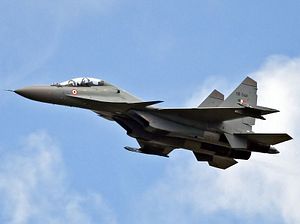Indian state-owned aircraft maker Hindustan Aeronautics Limited (HAL) has offered to produce 40 additional Sukhoi Su-30MKI multirole air superiority fighters for the Indian Air Force (IAF), according to local media reports.
Should the proposal be accepted by the Indian Ministry of Defense (MoD), the IAF’s fleet of Sukhoi Su-30MKIs would expand from the current 272 fighters to 312, divided up into 16 squadrons. HAL is currently producing the Su-30MKI at a flyaway cost of around USD$62 million per aircraft, while the competing French-made Dassault Rafale multirole fighter per-unit cost comes in at about USD$115 million (USD$85 million per official French documents).
HAL is presently assembling the last 23 Su-30MKI on order from the MoD.
The twin-seater, twin-engine Su-30MKI, developed by Russian aircraft maker Sukhoi and license-built in India, constitutes the backbone of the IAF. While the first 50 Su-30 aircraft were built in Russia, the remaining fighter jets were assembled in India. The IAF originally received the older Su-30MK variant from Russia, which the Indian defense industry in partnership with Russian defense companies upgraded to the MKI standard.
Unlike the Russian Su-30SM, the MKI version includes Israeli and French avionics. For example, the aircraft is fitted with a French-made heads-up display system, and an Israeli electronic warfare system and an advanced targeting pod. The Su-30MKI also features AL-37FP thrust-vectoring engines and canard foreplanes for increased maneuverability. HAL and Sukhoi are currently negotiating a contract for the upgrade of older Su-30MKI models in service with the IAF.
The IAF plans to upgrade its fleet of SU-30MKI to “Super Sukhois,” which includes fitting the aircraft with new long-range, precision-strike weapons systems, upgraded engines, and more advanced avionics. Contract negotiations are still ongoing. As I reported previously, the IAF is also looking to modify 40 Su-30MKI aircraft to carry the air-launched BrahMos-A supersonic cruise missile. As of now, two IAF Su-30 MKIs have been converted to fire the new 2.5-ton supersonic air-to-surface cruise missile.
The MoD order to retrofit the Su-30MKIs for the BrahMos-A was the initial impetus for HAL’s proposal to manufacture 40 additional aircraft. “We are required to modify 40-odd Sukhoi-30s to carry the BrahMos ALCM [air-launched cruise missile]. Instead of upgrading older fighters, with a shorter residual lifespan, it would be better to build three more squadrons of Sukhois with the capability to carry BrahMos missiles,” HAL chairman T. Suvarna Raju, told local media on May 15.
“It is easier and better to kit out new Su-30s to carry the BrahMos, rather than carrying out structural modifications to old aircraft,” he added.
The IAF is slated to receive 200 air-launched BrahMos-A missiles in the coming years. In order for the Su-30MKI to carry and launch the BrahMos-A, the aircraft’s undercarriage needs to be reinforced and hardened electronic circuitry to withstand the electromagnetic pulses of a nuclear blast — the missile can reportedly carry a nuclear warhead — installed, next to other modifications.
































